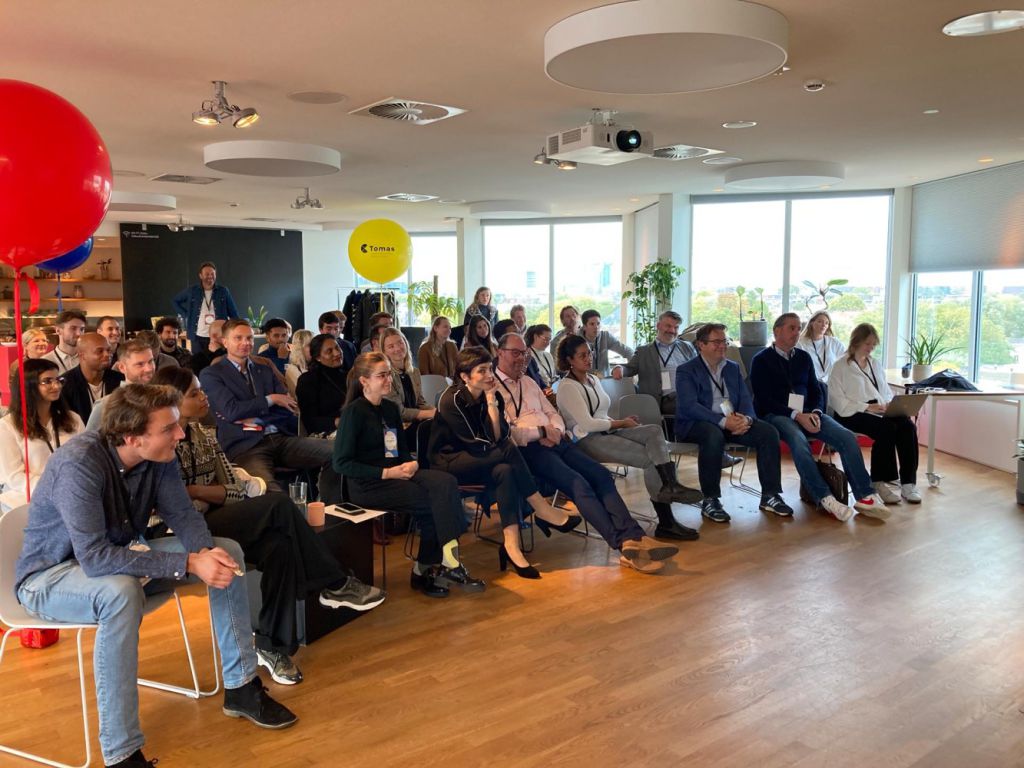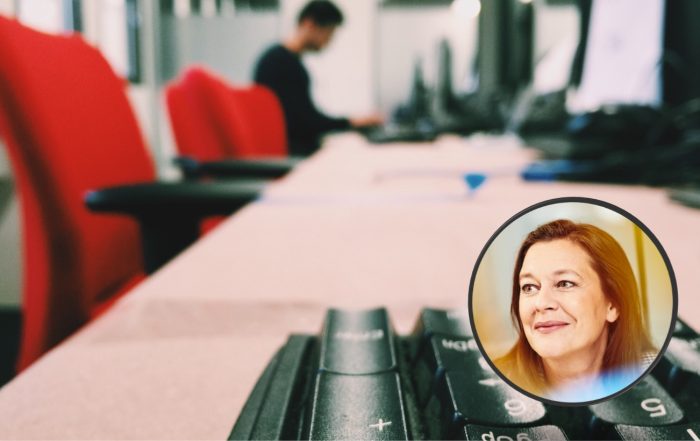TOMAS CONNECT #4: Tech talent aantrekken en behouden
Op vrijdag 7 oktober vond in Amsterdam de vierde editie van TOMAS CONNECT plaats. Onder leiding van Mark Wijsman kwamen 10 bedrijven en 11 initiatieven samen in Zoku om het meest recente beeld te krijgen van het lokale ecosysteem voor talentontwikkeling, hun behoeften te pitchen, strategische discussies aan te gaan en 1-op-1 matchmaking te hebben met de lokale helden.
Ze werden verwelkomd door Igneta Skliaustyte, Talent & Diversity Lead bij StartupAmsterdam, die het belang van het matchmaking-platform benadrukte: “De gemeente Amsterdam, Metropoolregio Amsterdam, HvA/Digital Society School, StartupAmsterdam en Amsterdam Economic Board hebben TOMAS opgericht om verbindingen te leggen. Zodat je van elkaar kunt leren en samen duurzame manieren voor werving kunt vinden, evenals enkele pijplijnen voor de lange termijn – niet alleen oplossingen voor de korte termijn.”
Igneta gaat verder in gesprek met de aanwezige talentinitiatieven: “Jullie leiden jaarlijks meer dan 2.000 mensen op. Daarnaast voegen jullie een enorme diversiteit toe aan de talentenpool door ondervertegenwoordigde gemeenschappen te activeren, bijvoorbeeld mensen met een vluchtelingenachtergrond. Jullie boren die verborgen plekken aan, trainen ook zachte en harde vaardigheden, en helpen met carrières. Dus jullie doen ongelooflijk werk. Stel je eens voor hoeveel impact jullie zouden hebben met nog meer erkenning en meer partnerschappen.”
“Amsterdam is een zeer, zeer hete markt”
Om die partnerschappen tot stand te helpen brengen, werden zeven techbedrijven uitgenodigd om te vertellen over de uitdagingen waarmee zij worden geconfronteerd bij het aannemen en behouden van technisch talent, waarbij zij zich rechtstreeks richten tot de deelnemende initiatieven in het publiek.
Sheyla Saadat, die bij Codaisseur aan Xillio werd voorgesteld, was de eerste die in het middelpunt stond. “Ik ben het levende voorbeeld van de samenwerking die we vandaag de dag zoeken. We zijn een van de beste in de markt zoals we zijn, omdat de menselijke kennis binnen ons bedrijf in stand wordt gehouden. Natuurlijk is het een uitdaging om synergieën te vinden, maar met vaste partners als Codaisseur slagen we erin die uitdaging aan te gaan. Onze pijplijn is bijna altijd vol. Wat we graag van u allen zouden horen is uw ervaring met retentiebeleid.”
Voor Dott zijn de grootste problemen de verhouding tussen junior en senior, genderdiversiteit en duurzame werving. Gunjam Sharma: “Ik wil eerlijk tegen je zijn. Het is een uitdaging omdat Amsterdam een zeer, zeer hete markt is. Dus ik zou graag van u willen weten, hoe houdt u ze bij u? Nog voordat ik TOMAS kende, werkten we samen met Codam, een van de initiatieven die hier vandaag ook aanwezig is. De grootste prestatie die ik bij hen heb gezien is dat we hun stagiaires hebben aangenomen. We willen lokaal talent en we willen ze fulltime in dienst nemen. Dat is het doel.”
TomTom pakt dit probleem aan met een hackathon, waarbij studenten de kans krijgen levensechte uitdagingen aan te gaan. “Wat niet veel mensen weten is dat wij in wezen een softwarebedrijf zijn”, legt Mariya Findzhikova uit. “TomTom Next is onze wereldwijde hackathon voor studenten. We gaan studenten van top tech instellingen mentorschap bieden van onze TomTom experts en we hopen ze op een informele manier te ontmoeten, met ze te praten en hopelijk kansen te kunnen bieden aan een aantal van de deelnemers.”
Allain Silbernberg van Ultimum daagt deelnemers aan TOMAS CONNECT #4 uit om samen te werken: “Mensen zijn ons grootste bezit. Hoe houd je mensen aan boord? Dat is een uitdaging. Laten we samen dingen maken. Daar roep ik eigenlijk toe op.”
Bob van de Worp van 2solar brengt het onderwerp purpose ter sprake. “Onze mensen vinden het erg leuk dat we een duurzaam energiebedrijf zijn. Het is niet de reden dat mensen komen, maar het is een methode om mensen te behouden. Mensen werken graag voor een bedrijf dat iets extra’s heeft naast het genereren van inkomsten voor de aandeelhouders.
“We beginnen een trend te zien waarbij senior ontwikkelaars van bijvoorbeeld Google en Facebook naar kleinere startups gaan met een veel grotere duurzaamheid en een soort sterkere bijdrage aan de impact op het milieu”, voegt hij eraan toe. Stylexxa’s Tumelo Setlaba die op zoek is naar betaalbare en getalenteerde mensen om de mode start-up te versterken.
“Als je voor Elsevier wilt werken, kun je een verschil maken in technologie gecombineerd met gezondheidszorg en wiskunde. Dus dat is iets wat ik mijn sollicitanten en kandidaten altijd vertel”, deelt recruiter Eli Marques. “Er zijn veel mogelijkheden bij Elsevier. Neem gerust contact met me op.”
“We zijn allemaal erg bang voor afwijzing.”
Na de eerste matchmakingsronde, waarin de initiatieven en bedrijven elkaar konden leren kennen en concrete kansen konden bespreken, geeft gastspreker Sarah Elbadr-Boers van Amsterdam Diverse & Inclusive enkele ideeën over hoe je diversiteit en inclusie op de werkvloer kunt stimuleren.
“We hebben de neiging te klikken met mensen die op ons lijken, mensen waarin we onszelf herkennen. Mensen nemen mensen aan die op hen lijken. Ik weet zeker dat jullie dit verhaal allemaal al eens gehoord hebben, maar het is een van de belangrijkste dingen waardoor dingen mis zullen gaan. Maar het grappige is dat we meestal denken dat we dit niet doen als we iemand aannemen. We denken dat we gaan voor de beste match. Maar wie bepaalt wat de beste match is?”
Het werkt ook andersom. “Als je een baan zoekt, kijk je op de website van het bedrijf hoeveel mensen op jou lijken. En dat is heel natuurlijk, want we zijn allemaal erg bang voor afwijzing.”
Deze zaken zijn te verhelpen met een goed diversiteits- en inclusieplan, en daar geeft Amsterdam Diverse & Inclusief gratis advies voor. “Het doel is niet alleen om mensen bij je te laten solliciteren, maar ook om ervoor te zorgen dat ze besluiten bij je bedrijf te blijven.”
Sarah deelt uit eigen ervaring: “Ik heb ooit een bedrijf gevonden waar ze op de website veel foto’s hebben met verschillende culturen, maar toen ik daar kwam, conformeerde iedereen zich eigenlijk aan wat er van hen verwacht wordt. Dus je hebt misschien diversiteit in culturen of geslachten, maar je krijgt geen diversiteit in perspectieven omdat niemand zich veilig voelt om zichzelf te zijn.”
“Er zijn veel verschillende aspecten van diversiteit en inclusie en mensen aantrekken is slechts de eerste stap, zoals jullie allemaal weten en vandaag al vaak hebben gehoord,” besluit Sarah.
“Ik werd mijn toekomstige zelf bij HackYourFuture”
Voor de laatste matchmaking-ronde delen HackYourFuture-alumni Bachar Daowd en Lama Gharib hun succesverhalen op het podium, samen met Partnerships Manager Federico Fusco.
HackYourFuture biedt een zeven maanden durende opleiding in webontwikkeling voor mensen met een vluchtelingenachtergrond. Na het programma worden studenten voorgesteld aan werkgevers om te beginnen met een stage die kan leiden tot een baan. HackYourFuture bestaat nu zes jaar en heeft 250 mensen aan een baan geholpen.
Bachar Daowd is een van hen. “Ik werkte als maatschappelijk werker, dus ik was bezig met het oplossen van problemen van mensen. Ik kwam hier en als vluchteling vond ik HackYourFuture. De eerste keer dat ik me aanmeldde werd ik afgewezen, net als de tweede keer. De derde keer werd ik aangenomen. En echt ik vond mezelf daar. Ik vond een baan en werd opnieuw geboren. Ik werd mijn toekomstige zelf bij HackYourFuture.”
Hoe voelt Federico zich daarbij? “Ik ga vaak naar deze evenementen en we praten veel over diversiteit en inclusie, wat ik heel belangrijk vind. Maar een van de dingen waar we het meest mee worstelen, is om bedrijven zoals de bedrijven die hier zijn zover te krijgen dat ze jong talent aannemen en daadwerkelijk de kans geven om een gesprek te voeren. Er zijn zoveel initiatieven die diversiteit en inclusie stimuleren, maar het is nog steeds de grootste uitdaging om onze studenten geïnterviewd te krijgen.”
De tekst gaat verder onder de afbeelding

Naast programmeervaardigheden is het belangrijkste de mentaliteit, zegt Lama, die vroeger in het bankwezen werkte. “En om te leren hoe je jezelf nieuwe vaardigheden kunt aanleren om mee te beginnen. Ik denk dat dat het belangrijkste is dat ik van HackYourFuture heb meegenomen. Nu weet ik hoe ik moet beginnen met dingen vanaf nul te leren en hoe ik problemen moet benaderen en oplossen.”
Nu met een adviesbureau, vond Lama dat HackYourFuture haar voorbereidde op het werken bij een bedrijf: “In het begin dacht ik dat dat niet zo was en was ik bang. Maar HackTheFuture is eigenlijk een soort simulatie van de werkelijkheid. Je werkt met een team in een agile systeem. Dus we zijn klaar om te beginnen.”
Federico voegt eraan toe: “Het leuke is ook dat het meeste onderwijs door vrijwilligers wordt gegeven. En we richten ons niet alleen op technische zaken, maar ook op sociale vaardigheden, zodat we onze studenten daadwerkelijk kunnen helpen om uiteindelijk die baan te krijgen. Er zijn een paar honderd mensen betrokken bij het helpen van mensen als Lama en Bachar om echt klaar te zijn, want voor ons begint het met een stage die tot een baan leidt. Maar we blijven heel nauw samenwerken met onze studenten tot ze een baan vinden waarmee ze hun rekeningen kunnen betalen en de mensen kunnen steunen van wie ze houden. Dus dat is wat ons echt op gang brengt.”
Bachar vond een baan als codeur bij ABN AMRO. “Ze steunen veel nieuwkomers en vluchtelingen. Mensen uit Oekraïne en uit Iran. We lieten hen mijn CV en mijn projecten zien en ze zeiden me, als je wordt aangenomen, moet je Java, Azure en enkele andere technologieën leren. Dus eigenlijk is dat wat ik zeg over HackYourFuture. Het is geen proces van alleen leren coderen. Het is een mentaliteit dat je altijd moet groeien en iets nieuws moet leren. Dus ik was zo enthousiast en ben eigenlijk bij ABN AMRO gaan werken.”
“De bedrijven waarmee we werken, vinden ook buiten diversiteit en inclusie echt zakelijke waarde”, zegt Federico. “Dus praat met onze studenten. Ik kan de wereld verkopen want ik heb mensen als Bachar en Lama die zeggen, je hebt mijn leven veranderd. Ja, dat is mooi.”
Het volgende TOMAS CONNECT evenement vindt plaats in Flevoland en staat in het teken van de technische sector. Ben jij een bedrijf of talentinitiatief dat wil pitchen of deelnemen aan het evenement? Neem contact op met onze community manager Björn Schouten via bjorn@vraaghettomas.nl.
.
20 oktober 2022
Meer weten over
Neem contact op
Blijf jij ook op de hoogte?
8x per jaar nieuws en events uit de regio: schrijf je in voor de Board Update nieuwsbrief
Deel dit artikel
Wil je op de hoogte blijven?
Volg ons dagelijks op LinkedIn en schrijf je in voor de Board Update nieuwsbrief.
Lees ook deze berichten
- Een nieuwe lichting gedreven jongeren is aangetreden bij Young on Board, de ...
- Met de selectie van vier kanshebbers is de regionale voorronde van de ...
- Met meer dan 80 ondernemers, 40 investeerders en diverse dienstverleners bood LSH Capital Match ...



